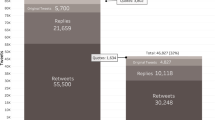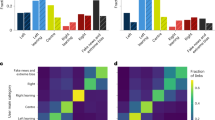Abstract
Social media analysis is a fast growing research area aimed at extracting useful information from social networks. Recent years have seen a great interest from academic and business world in using social media to measure public opinion. This paper presents a methodology aimed at discovering the behavior of social network users and how news sites are used during political campaigns characterized by the rivalry of different factions. As a case study, we present an analysis on the constitutional referendum that was held in Italy on December 4, 2016. A first goal of the analysis was to study how Twitter users expressed their voting intentions about the referendum in the weeks before the voting day, so as to understand how the voting trends have evolved before the vote, e.g., if there have been changes in the voting intentions. According to our study, 48% of Twitter users were polarized toward no, 25% toward yes, and 27% had a neutral behavior. A second goal was to understand the effects of news sites on the referendum campaign. The analysis has shown that some news sites had a strong polarization toward yes (unita.tv, ilsole24ore.it and linkiesta.it), some others had a neutral position (lastampa.it, corriere.it, huffingtonpost.it and repubblica.it) and others were oriented toward no (ilfattoquotidiano.it, ilgiornale.it and beppegrillo.it).









Similar content being viewed by others
Notes
Twitter API, https://dev.twitter.com/overview/api/tweets.
Twitter API, https://dev.twitter.com/overview/api/users.
Italian language, https://it.wikipedia.org/wiki/Lingua_italiana.
References
Anstead N, O’Loughlin B (2015) Social media analysis and public opinion: the 2010 UK general election. J Comput Mediat Commun 20(2):204–220. https://doi.org/10.1111/jcc4.12102
Belcastro L, Marozzo F, Talia D, Trunfio P (2017) Big data analysis on clouds. In: Sakr S, Zomaya A (eds) Handbook of big data technologies. Springer, Berlin, pp 101–142. https://doi.org/10.1007/978-3-319-49340-4_4 ISBN: 978-3-319-49339-8
Bessi A, Coletto M, Davidescu GA, Scala A, Caldarelli G, Quattrociocchi W (2015) Science versus conspiracy: collective narratives in the age of misinformation. PloS One 10(2):e0118093
Breiman L (2001) Random forests. Mach Learn 45(1):5–32
Burnap P, Gibson R, Sloan L, Southern R, Williams M (2016) 140 Characters to victory? Using twitter to predict the UK 2015 general election. Electoral Stud 41:230–233
Ceron A, Curini L, Iacus SM, Porro G (2014) Every tweet counts? How sentiment analysis of social media can improve our knowledge of citizenspolitical preferences with an application to Italy and France. New Media Soc 16(2):340–358
Cesario E, Congedo C, Marozzo F, Riotta G, Spada A, Talia D, Trunfio P, Turri C (2015) Following soccer fans from geotagged tweets at fifa world cup 2014. In: Proceedings of the 2nd IEEE conference on spatial data mining and geographical knowledge services, pp 33–38. Fuzhou, China. ISBN 978-1-4799-7748-2
Cesario E, Iannazzo AR, Marozzo F, Morello F, Riotta G, Spada A, Talia D, Trunfio P (2016) Analyzing social media data to discover mobility patterns at expo 2015: methodology and results. In: The 2016 international conference on high performance computing and simulation (HPCS 2016), pp. 230–237. Innsbruck, Austria. ISBN: 978-1-5090-2088-1.
Dallmann A, Lemmerich F, Zoller D, Hotho A (2015) Media bias in German online newspapers. In: Proceedings of the 26th ACM conference on hypertext and social media, pp 133–137. ACM
Elmer G (2013) Live research: Twittering an election debate. New Media Soc 15(1):18–30. https://doi.org/10.1177/1461444812457328
Franch F (2013) 2010 UK election prediction with social media. J Inform Technol Polit 10(1):57–71. https://doi.org/10.1080/19331681.2012.705080
Gokulakrishnan B, Priyanthan P, Ragavan T, Prasath N, Perera A (2012) Opinion mining and sentiment analysis on a twitter data stream. In: 2012 International conference on advances in ICT for emerging regions (ICTer), pp 182–188. IEEE
Gonzalez-Bailon S, Banchs RE, Kaltenbrunner A (2010) Emotional reactions and the pulse of public opinion: measuring the impact of political events on the sentiment of online discussions. In: CoRR, abs/1009.4019
Gruzd A, Roy J (2014) Investigating political polarization on twitter: a Canadian perspective. Policy Internet 6(1):28–45
Hanna R, Rohm A, Crittenden VL (2011) Were all connected: the power of the social media ecosystem. Bus Horiz 54(3):265–273
Hermida A, Fletcher F, Korell D, Logan D (2012) Share, like, recommend. J Stud 13(5–6):815–824. https://doi.org/10.1080/1461670X.2012.664430
Hopkins DJ, King G (2010) A method of automated nonparametric content analysis for social science. Am J Polit Sci 54(1):229–247
Howard PN, Duffy A, Freelon D, Hussain MM, Mari W, Maziad M (2011) Opening closed regimes: what was the role of social media during the arab spring? SSRN. https://doi.org/10.2139/ssrn.2595096
Jungherr A (2016) Twitter use in election campaigns: a systematic literature review. J Inform Technol Polit 13(1):72–91. https://doi.org/10.1080/19331681.2015.1132401
Kagan V, Stevens A, Subrahmanian V (2015) Using twitter sentiment to forecast the 2013 Pakistani election and the 2014 Indian election. IEEE Intell Syst 30(1):2–5
Kwon S, Cha M, Jung K, Chen W, Wang Y (2013) Prominent features of rumor propagation in online social media. In: 2013 IEEE 13th international conference on data mining (ICDM), pp 1103–1108. IEEE
Lerman K, Ghosh R (2010) Information contagion: an empirical study of the spread of news on digg and Twitter social networks. In: CoRR, abs/1003.2664
Lievrouw L, Gillespie T, Boczkowski P, Foot K (2014) Materiality and media in communication and technology studies: an unfinished project. Media technologies: essays on communication, materiality, and society, pp 21–51
Monti C, Rozza A, Zappella G, Zignani M, Arvidsson A, Colleoni E (2013) Modelling political disaffection from twitter data. In: Proceedings of the second international workshop on issues of sentiment discovery and opinion mining, p 3. ACM
Murphy J, Link MW, Childs JH, Tesfaye CL, Dean E, Stern M, Pasek J, Cohen J, Callegaro M, Harwood P (2014) Social media in public opinion research executive summary of the aapor task force on emerging technologies in public opinion research. Public Opin Q 78(4):788. https://doi.org/10.1093/poq/nfu053
Nulty P, Theocharis Y, Popa SA, Parnet O, Benoit K (2016) Social media and political communication in the 2014 elections to the European parliament. Electoral Stud 44:429–444
O’Connor B, Balasubramanyan R, Routledge BR, Smith NA (2010) From tweets to polls: linking text sentiment to public opinion time series. ICWSM 11(122–129):1–2
Pang B, Lee L (2008) Opinion mining and sentiment analysis. Found Trends Inform Retr 2(1–2):1–135. https://doi.org/10.1561/1500000011
Talia D, Trunfio P, Marozzo F (2015) Data analysis in the cloud. Elsevier, Amsterdam
Tufte ER (1986) The visual display of quantitative information. Graphics Press, Cheshire
Tumasjan A, Sprenger TO, Sandner PG, Welpe IM (2010) Predicting elections with Twitter: what 140 characters reveal about political sentiment. ICWSM 10(1):178–185
Van Asch V (2013) Macro-and micro-averaged evaluation measures. Technical report
Wagner JP (2017) The media and national identity: local newspapers coverage of Scottish independence during the campaign of the 2014 Scottish independence referendum. In: Dealing with the local
Zhang K, Cheng Y, Xie Y, Honbo D, Agrawal A, Palsetia D, Lee K, Liao WK, Choudhary A (2011) SES: sentiment elicitation system for social media data. In: 2011 IEEE 11th international conference on data mining workshops (ICDMW), pp 129–136. IEEE
Author information
Authors and Affiliations
Corresponding author
Rights and permissions
About this article
Cite this article
Marozzo, F., Bessi, A. Analyzing polarization of social media users and news sites during political campaigns. Soc. Netw. Anal. Min. 8, 1 (2018). https://doi.org/10.1007/s13278-017-0479-5
Received:
Revised:
Accepted:
Published:
DOI: https://doi.org/10.1007/s13278-017-0479-5




